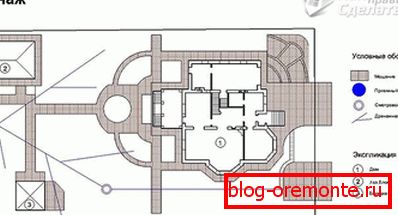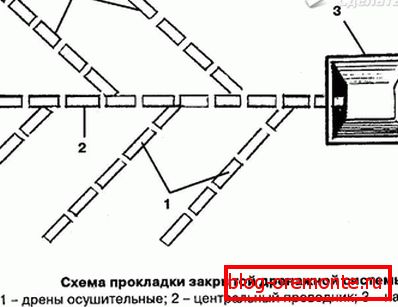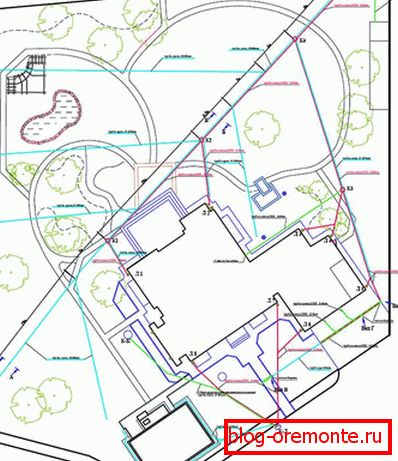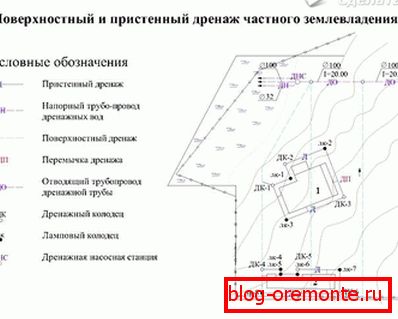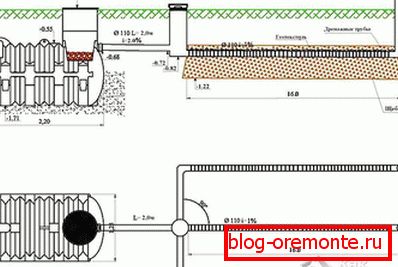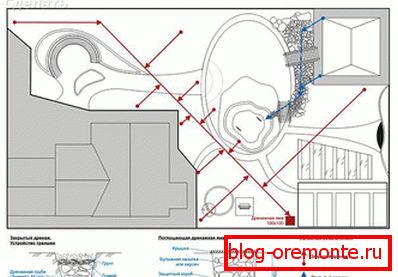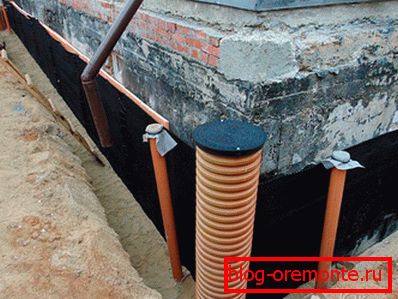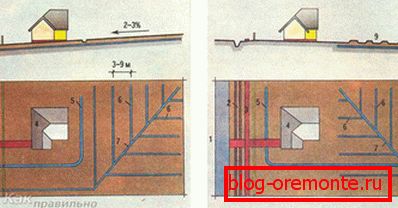Drainage plot with their own hands
It is better to entrust the drainage of the suburban area to the specialists, however, if there is no such possibility, then you can try to figure everything out on your own. First of all, it is necessary to disassemble the types of drainage and the various schemes of its device, as well as its purpose. Drainage is simply necessary because this system protects the house and the plot from excessive moisture. If it is set incorrectly, the effect may be the opposite. This will lead to flooding and washing out of the soil.
Kinds
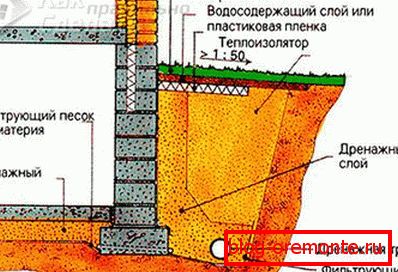 To begin with, it is necessary to make out its types and find out the peculiarities of each.
To begin with, it is necessary to make out its types and find out the peculiarities of each.
Drainage can happen:
- superficial;
- deep.
Surface drainage can be done without the involvement of masters. This is a relatively simple job.
Deep дренаж лучше всего производить еще на этапе постройки дома.
The structure also needs protection. It often happens that the flow of groundwater penetrates the underground space. Water can flood the cellar, garage, underground parking or rest room. It all depends on what is below the surface of the earth.
Surface
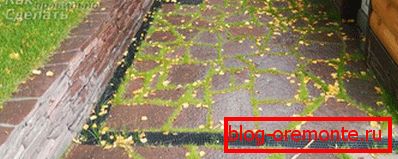
Surface drainage of the site is carried out with the help of various inlets and trays. This type of drainage got its name because the whole system is located on the surface. Trays can successfully cope with the flow of rainwater, as well as moisture, which is formed as a result of melting snow.
Surface дренаж бывает двух типов: точечный и линейный.
- Spot. Such a system consists of water collectors, which, in turn, are associated with sewage. Water collecting devices are usually installed under gutters, in lowlands and under taps.
- Linear. The system resembles a channel that has a slope toward the well. It is there that moisture comes from showers.
This is not to say that one of the types of drainage is better than the other. Often both species are used together for greater efficiency. All devices in the system require regular cleaning, otherwise they cease to function properly. Well-organized gutter is excellent and copes with its task.
Dotted

When the spot layout trays are installed, first of all, under the sewer pipes at home. Otherwise, the water will constantly fall on the foundation and on the site.
Improper layout will lead to the penetration of moisture into the underground space.
Trays must be installed so that they are underground. From them will have to hold the pipe to the sewer. From above the tray is covered with a grill. This is a protective and decorative element at the same time. To clean the tray, you just need to lift the grate and remove debris from the container.
Linear
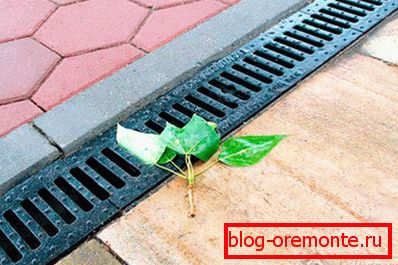
The linear system has been known for a very long time. It was used in ancient Egypt and Babylon. Today, only the materials used have changed, but the principle of work has remained the same.
 Plastic or reinforced concrete trays are used for drainage. They are fitted on top with a grill that covers the gutter. The system has garbage collectors that facilitate the process of caring for trays.
Plastic or reinforced concrete trays are used for drainage. They are fitted on top with a grill that covers the gutter. The system has garbage collectors that facilitate the process of caring for trays.
The installation of such systems is necessary in cases where:
- protection of the foundation from rainwater;
- there is a risk of soil blurring;
- there is a need to drain moisture from sheds, garages and other structures located in the valley;
- for protection of paths on garden and dacha sites.
Installation of water flow will not be a complicated procedure, even for a beginner. His device is very clear.
Deep
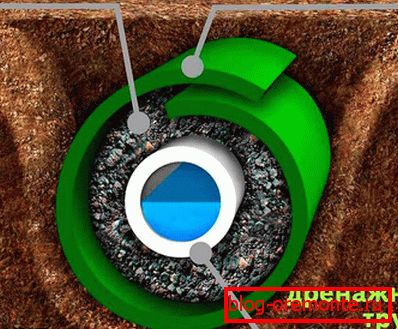
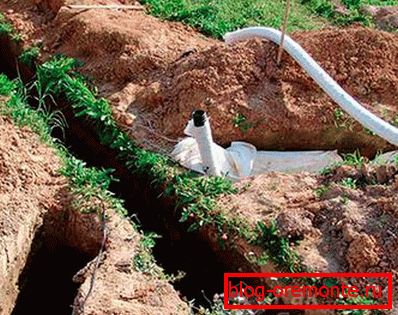
Usually both types of drainage are installed on the plots: both deep and surface. Such a drainage network will provide absolute protection from moisture.
Before arranging the buried system, it is necessary to determine which way the water flows during the showers. This indicator is one of the most important.
If you make a mistake with the level of bias, you can hurt yourself with your own work.
Know the direction of water flow is possible without studying the area. To do this, just wait for the first shower and see where the streams are going.
- When the direction of flow is determined, it is necessary to stock up drainage pipes and geotextiles. Instead of geotextiles, you can take any other material that passes water well.
- On the site trench breaks out. Their scheme resembles a Christmas tree.
- We must once again make sure that the right direction is chosen. All possible errors are easily fixed at this stage of work. We must leave the trenches open before the first rain. If done correctly, the water will flow in the right direction. If the water is in the trenches, then you have to redo everything, because this indicates an insufficient drain bias. If the water flows, on the contrary, to the site, then this is an error in determining the side of the slope.
- If the trenches have passed the test, you can continue the deepening of drains. Tubes are cut into pieces of the desired length and sealed together.
- Drains are laid in trenches. Before laying the tube it is necessary to wrap it with geotextile. This allows the system to easily drain water and at the same time prevents it from clogging. To make a simple drainage system of the recessed type, it is necessary to dig a trench half a meter deep. In this case, it will work effectively in the warm season. In order for drainage to function both in cold time and during the thaw period, it is necessary to make trenches with a depth of at least one meter. Also in this case it will be necessary to install special wells. Practice shows that simple construction is enough to protect the site and the house from moisture.
 Trenches are filled with rubble and small stones. This will allow moisture to flow easily to the pipes.
Trenches are filled with rubble and small stones. This will allow moisture to flow easily to the pipes. - Pipes are discharged into trunk wells and trenches. You can bring them to other sources of the drainage system.
The general scheme of drainage: well-receiver, drainage and collector, which removes excess moisture.
Calculation and design always depend on the features of each particular site. You can not take and install all the same system. Somewhere additional means of drainage are required, and somewhere the simplest device will do. In a pinch, you can refer to the maps to determine the nature of your site.
Even with the availability of data from the maps one should not neglect the additional practical calibration of the slope. In case if it is not possible in some places to achieve the desired direction of flow, you can try to fix it with the help of embankments. However, this procedure is also not carried out without preliminary calculations. A number of problems can be solved with the help of a drainage pump. This is a forced drainage system, which is used in cases where it is impossible to create a natural one, or an additional water delivery device is required.
On clay soils

Not all types of soils well pass water. These include clay. Clay soil is characterized by an excess of moisture. Because of this, the right amount of oxygen is not supplied to the roots. As a result, the plants die. Dense turf also leads to oxygen starvation of plants.
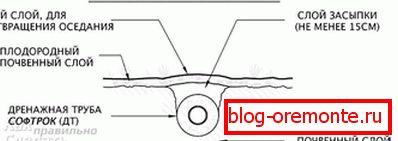
When arranging the drainage system of a small area, it is not necessary to do the calculation in the design process. In this case, it is necessary to take into account the parameters relating to drains:
- slope;
- location according to plan;
- depth of occurrence;
- distance between rows;
- device of the mouth part and manholes.
It is better to use the natural relief of the section with a slope when constructing a drainage system.
Use of relief
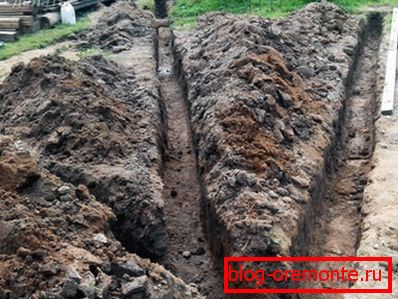
It is easier to work with an inclined section than with a flat one. This is due at least to a reduction in labor costs. All you need is to competently combine open and closed drainage.
The clay soil is dense and heavy, so to improve the drainage properties of the soil should be carefully loosened. In the process of laying drains, it is necessary to bypass the places intended for the passage of the car.
On peat soils

In peatlands, groundwater levels are usually high. Because of this, these types of soils are practically not used for growing plants. In peatlands, the root system of plants simply rot.
Drainage of peatlands can reduce the level of groundwater to 2-2.5 m. No need to do this if your site has already been carried out drainage of the soil. This can be easily determined. Drainage was carried out at the site if there is no stagnation of melt water on it, and the groundwater level in the flood does not exceed 1.5 m.
This is only found on lowland peatlands or cultivated land. Most often on the peatlands one can observe a picture when the water is close, and in spring even in some places it is not absorbed into the ground. The only exception is the hot summer, when the groundwater level is greatly reduced, as a result of which the peat dries out and needs watering. Perennial roots are very affected during the thaw period in winter or spring. In such a situation, over time, the death of plants is inevitable.

Not everything is so regrettable. Peatlands can be drained. What can be done for this? If the water is at a level of 0.8–1.2 m, then its excess can be easily diverted from the site, for example, by planting birch trees or viburnum bushes in the north-western side of the site or beyond. The fact is that birches actively collect moisture at a distance of 30 m from themselves. So, you drain the area, while not shading it with these trees.
If the water is closer, then you have to make a high-quality drainage system. To do this, divide the area into sectors. In this case, the drainage ditches are placed in the slope of the place for collecting water. In the lower corner of the plot, dig out a drain well or make an artificial reservoir. All the excess water from the peat area will flow into it. If you decide to make a water collector in the form of a well, the summer drought accumulated water can be used for irrigation.
Land around a pond of moisture-loving fruit / ornamental crops.
Two ditches should pass along the edges of the land plot, transverse ones should be provided for high-quality drainage of the peat bog. For example, for 6 acres it is enough to make 1–2 transverse ditches. The depth of the ditch should reach about 40–50 cm. When digging a trench, dump the top layer of soil on the edges of the beds that will be settled later.
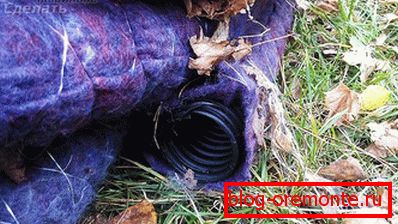
For safety, it is better to make a closed drainage system. The principle of its installation will be described below.
It is impossible for water to accumulate at least on a small patch of land - melt or rain. If you find those clusters, then make in such places mounds of soil and sand, as well as fertile soil. The drainage sleeves should converge to the well / reservoir.
On peat plants should be grown on raised beds. If peat dries out in the summer due to heat, it will need to be watered regularly and abundantly.
In cases when the groundwater level cannot be lowered to the level of 2 m, fruit trees on it will need to be planted on artificial hills having a height of 30-50 cm. At the same time, as the tree grows, the diameter of the hill should be increased.
Errors in the arrangement

The most common mistake in arranging the drainage system is that it is installed without proper design. When installing drainage pipes and systems it is necessary, first of all, to understand the situation. It is necessary to analyze the site itself and the nature of groundwater.
For example, water very often affects the foundation. To protect it, you need to design a drainage system when building a house. In this case, you will need to install an additional basement, which will serve as a barrier to groundwater. If the design was made incorrectly, then the situation can only be complicated. Groundwater will flow into the basement and affect the foundation. In difficult cases, you will need to contact specialists.
Video
Scheme
These schemes will help you plan the drainage area according to the requirements:
